#SQL Server add column
Explore tagged Tumblr posts
Text
Adding a Column with Default Value to an Existing Table in SQL Server
To add a column with a default value to an existing table in SQL Server, you can use the ALTER TABLE statement combined with the ADD clause. The general syntax for adding a new column with a default value is as follows: ALTER TABLE TableName ADD ColumnName DataType DEFAULT DefaultValue; Here’s a step-by-step breakdown of the syntax: ALTER TABLE TableName: This specifies that you’re modifying…
View On WordPress
#ALTER TABLE SQL Server#default value SQL#modify table SQL#SQL Server add column#SQL Server database management
0 notes
Text
Structured Query Language (SQL): A Comprehensive Guide
Structured Query Language, popularly called SQL (reported "ess-que-ell" or sometimes "sequel"), is the same old language used for managing and manipulating relational databases. Developed in the early 1970s by using IBM researchers Donald D. Chamberlin and Raymond F. Boyce, SQL has when you consider that end up the dominant language for database structures round the world.
Structured query language commands with examples

Today, certainly every important relational database control system (RDBMS)—such as MySQL, PostgreSQL, Oracle, SQL Server, and SQLite—uses SQL as its core question language.
What is SQL?
SQL is a website-specific language used to:
Retrieve facts from a database.
Insert, replace, and delete statistics.
Create and modify database structures (tables, indexes, perspectives).
Manage get entry to permissions and security.
Perform data analytics and reporting.
In easy phrases, SQL permits customers to speak with databases to shop and retrieve structured information.
Key Characteristics of SQL
Declarative Language: SQL focuses on what to do, now not the way to do it. For instance, whilst you write SELECT * FROM users, you don’t need to inform SQL the way to fetch the facts—it figures that out.
Standardized: SQL has been standardized through agencies like ANSI and ISO, with maximum database structures enforcing the core language and including their very own extensions.
Relational Model-Based: SQL is designed to work with tables (also called members of the family) in which records is organized in rows and columns.
Core Components of SQL
SQL may be damaged down into numerous predominant categories of instructions, each with unique functions.
1. Data Definition Language (DDL)
DDL commands are used to outline or modify the shape of database gadgets like tables, schemas, indexes, and so forth.
Common DDL commands:
CREATE: To create a brand new table or database.
ALTER: To modify an present table (add or put off columns).
DROP: To delete a table or database.
TRUNCATE: To delete all rows from a table but preserve its shape.
Example:
sq.
Copy
Edit
CREATE TABLE personnel (
id INT PRIMARY KEY,
call VARCHAR(one hundred),
income DECIMAL(10,2)
);
2. Data Manipulation Language (DML)
DML commands are used for statistics operations which include inserting, updating, or deleting information.
Common DML commands:
SELECT: Retrieve data from one or more tables.
INSERT: Add new records.
UPDATE: Modify existing statistics.
DELETE: Remove information.
Example:
square
Copy
Edit
INSERT INTO employees (id, name, earnings)
VALUES (1, 'Alice Johnson', 75000.00);
three. Data Query Language (DQL)
Some specialists separate SELECT from DML and treat it as its very own category: DQL.
Example:
square
Copy
Edit
SELECT name, income FROM personnel WHERE profits > 60000;
This command retrieves names and salaries of employees earning more than 60,000.
4. Data Control Language (DCL)
DCL instructions cope with permissions and access manage.
Common DCL instructions:
GRANT: Give get right of entry to to users.
REVOKE: Remove access.
Example:
square
Copy
Edit
GRANT SELECT, INSERT ON personnel TO john_doe;
five. Transaction Control Language (TCL)
TCL commands manage transactions to ensure data integrity.
Common TCL instructions:
BEGIN: Start a transaction.
COMMIT: Save changes.
ROLLBACK: Undo changes.
SAVEPOINT: Set a savepoint inside a transaction.
Example:
square
Copy
Edit
BEGIN;
UPDATE personnel SET earnings = income * 1.10;
COMMIT;
SQL Clauses and Syntax Elements
WHERE: Filters rows.
ORDER BY: Sorts effects.
GROUP BY: Groups rows sharing a assets.
HAVING: Filters companies.
JOIN: Combines rows from or greater tables.
Example with JOIN:
square
Copy
Edit
SELECT personnel.Name, departments.Name
FROM personnel
JOIN departments ON personnel.Dept_id = departments.Identity;
Types of Joins in SQL
INNER JOIN: Returns statistics with matching values in each tables.
LEFT JOIN: Returns all statistics from the left table, and matched statistics from the right.
RIGHT JOIN: Opposite of LEFT JOIN.
FULL JOIN: Returns all records while there is a in shape in either desk.
SELF JOIN: Joins a table to itself.
Subqueries and Nested Queries
A subquery is a query inside any other query.
Example:
sq.
Copy
Edit
SELECT name FROM employees
WHERE earnings > (SELECT AVG(earnings) FROM personnel);
This reveals employees who earn above common earnings.
Functions in SQL
SQL includes built-in features for acting calculations and formatting:
Aggregate Functions: SUM(), AVG(), COUNT(), MAX(), MIN()
String Functions: UPPER(), LOWER(), CONCAT()
Date Functions: NOW(), CURDATE(), DATEADD()
Conversion Functions: CAST(), CONVERT()
Indexes in SQL
An index is used to hurry up searches.
Example:
sq.
Copy
Edit
CREATE INDEX idx_name ON employees(call);
Indexes help improve the performance of queries concerning massive information.
Views in SQL
A view is a digital desk created through a question.
Example:
square
Copy
Edit
CREATE VIEW high_earners AS
SELECT call, salary FROM employees WHERE earnings > 80000;
Views are beneficial for:
Security (disguise positive columns)
Simplifying complex queries
Reusability
Normalization in SQL
Normalization is the system of organizing facts to reduce redundancy. It entails breaking a database into multiple related tables and defining overseas keys to link them.
1NF: No repeating groups.
2NF: No partial dependency.
3NF: No transitive dependency.
SQL in Real-World Applications
Web Development: Most web apps use SQL to manipulate customers, periods, orders, and content.
Data Analysis: SQL is extensively used in information analytics systems like Power BI, Tableau, and even Excel (thru Power Query).
Finance and Banking: SQL handles transaction logs, audit trails, and reporting systems.
Healthcare: Managing patient statistics, remedy records, and billing.
Retail: Inventory systems, sales analysis, and consumer statistics.
Government and Research: For storing and querying massive datasets.
Popular SQL Database Systems
MySQL: Open-supply and extensively used in internet apps.
PostgreSQL: Advanced capabilities and standards compliance.
Oracle DB: Commercial, especially scalable, agency-degree.
SQL Server: Microsoft’s relational database.
SQLite: Lightweight, file-based database used in cellular and desktop apps.
Limitations of SQL
SQL can be verbose and complicated for positive operations.
Not perfect for unstructured information (NoSQL databases like MongoDB are better acceptable).
Vendor-unique extensions can reduce portability.
Java Programming Language Tutorial
Dot Net Programming Language
C ++ Online Compliers
C Language Compliers
2 notes
·
View notes
Text
So in case you're wondering what I've been up to for the last month or so (no one is here), I've been working on this-
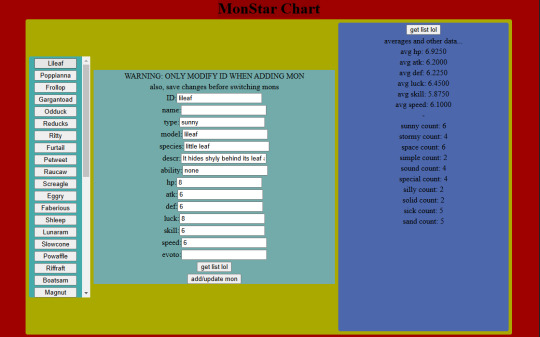
A CRUD app! Because that seems to be what everyone's making these days. It's an editor for monster data. Because, like, all the tutorials were for managing employee data and shit, but this is what data I have that needs managing. It's got a React js frontend and a javascript backend.
It basically runs off this list of data that spawns the entry rows and stuff, so I can add to it easily or reuse the base code between projects:
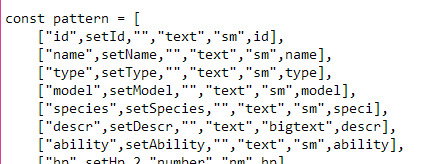
That's neat, but it was a real pain in the ass to have to start up both the client and the server whenever I wanted to use it, so I made basically the same thing but in Python with tkinter:
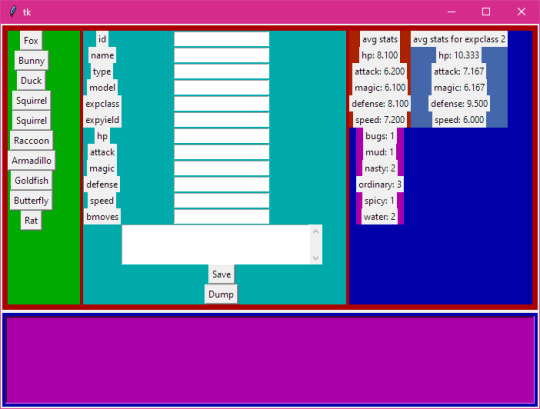
And as an example of reuse here's it being used for moves data-
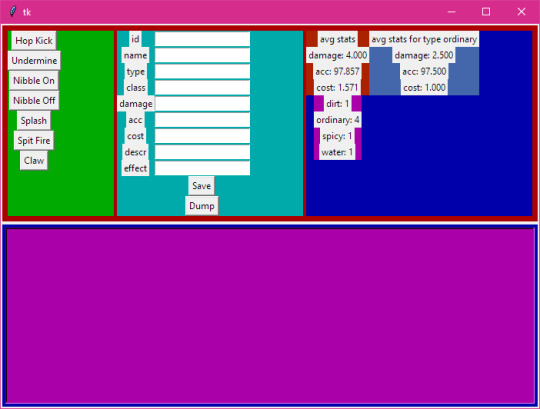
A lot of things are made easier with this. Mainly there's only one data list, whereas the CRUD app needed the state hooks declared, then the data list including the "pointers" to the state variables and setter functions, then the backend needed its own list of the names of the SQL columns.
This version has some extra features like, if you add something to the data list it'll add a column to the SQL database for you. Plus Python is similar to GDScript, so I could bundle a basic version of it with the Mondo code.
Meanwhile I've been upgrading the battle system to handle multiple mons in one battle-
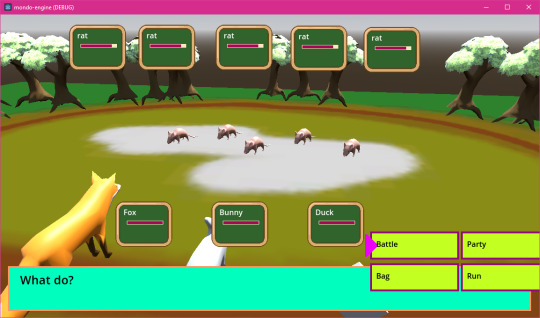
Next I'm probably going to step back a bit and document the code, because it's becoming a bit messy and I need to clean it up
5 notes
·
View notes
Text
Cross-Mapping Tableau Prep Workflows into Power Query: A Developer’s Blueprint
When migrating from Tableau to Power BI, one of the most technically nuanced challenges is translating Tableau Prep workflows into Power Query in Power BI. Both tools are built for data shaping and preparation, but they differ significantly in structure, functionality, and logic execution. For developers and BI engineers, mastering this cross-mapping process is essential to preserve the integrity of ETL pipelines during the migration. This blog offers a developer-centric blueprint to help you navigate this transition with clarity and precision.
Understanding the Core Differences
At a foundational level, Tableau Prep focuses on a flow-based, visual paradigm where data steps are connected in a linear or branching path. Power Query, meanwhile, operates in a functional, stepwise M code environment. While both support similar operations—joins, filters, aggregations, data type conversions—the implementation logic varies.
In Tableau Prep:
Actions are visual and sequential (Clean, Join, Output).
Operations are visually displayed in a flow pane.
Users rely heavily on drag-and-drop transformations.
In Power Query:
Transformations are recorded as a series of applied steps using the M language.
Logic is encapsulated within functional scripts.
The interface supports formula-based flexibility.
Step-by-Step Mapping Blueprint
Here’s how developers can strategically cross-map common Tableau Prep components into Power Query steps:
1. Data Input Sources
Tableau Prep: Uses connectors or extracts to pull from databases, Excel, or flat files.
Power Query Equivalent: Use “Get Data” with the appropriate connector (SQL Server, Excel, Web, etc.) and configure using the Navigator pane.
✅ Developer Tip: Ensure all parameters and credentials are migrated securely to avoid broken connections during refresh.
2. Cleaning and Shaping Data
Tableau Prep Actions: Rename fields, remove nulls, change types, etc.
Power Query Steps: Use commands like Table.RenameColumns, Table.SelectRows, and Table.TransformColumnTypes.
✅ Example: Tableau Prep’s “Change Data Type” ↪ Power Query:
mCopy
Edit
Table.TransformColumnTypes(Source,{{"Date", type date}})
3. Joins and Unions
Tableau Prep: Visual Join nodes with configurations (Inner, Left, Right).
Power Query: Use Table.Join or the Merge Queries feature.
✅ Equivalent Code Snippet:
mCopy
Edit
Table.NestedJoin(TableA, {"ID"}, TableB, {"ID"}, "NewColumn", JoinKind.Inner)
4. Calculated Fields / Derived Columns
Tableau Prep: Create Calculated Fields using simple functions or logic.
Power Query: Use “Add Column” > “Custom Column” and M code logic.
✅ Tableau Formula Example: IF [Sales] > 100 THEN "High" ELSE "Low" ↪ Power Query:
mCopy
Edit
if [Sales] > 100 then "High" else "Low"
5. Output to Destination
Tableau Prep: Output to .hyper, Tableau Server, or file.
Power BI: Load to Power BI Data Model or export via Power Query Editor to Excel or CSV.
✅ Developer Note: In Power BI, outputs are loaded to the model; no need for manual exports unless specified.
Best Practices for Developers
Modularize: Break complex Prep flows into multiple Power Query queries to enhance maintainability.
Comment Your Code: Use // to annotate M code for easier debugging and team collaboration.
Use Parameters: Replace hardcoded values with Power BI parameters to improve reusability.
Optimize for Performance: Apply filters early in Power Query to reduce data volume.
Final Thoughts
Migrating from Tableau Prep to Power Query isn’t just a copy-paste process—it requires thoughtful mapping and a clear understanding of both platforms’ paradigms. With this blueprint, developers can preserve logic, reduce data preparation errors, and ensure consistency across systems. Embrace this cross-mapping journey as an opportunity to streamline and modernize your BI workflows.
For more hands-on migration strategies, tools, and support, explore our insights at https://tableautopowerbimigration.com – powered by OfficeSolution.
0 notes
Text
DBMS Tutorial Explained: Concepts, Types, and Applications

In today’s digital world, data is everywhere — from social media posts and financial records to healthcare systems and e-commerce websites. But have you ever wondered how all that data is stored, organized, and managed? That’s where DBMS — or Database Management System — comes into play.
Whether you’re a student, software developer, aspiring data analyst, or just someone curious about how information is handled behind the scenes, this DBMS tutorial is your one-stop guide. We’ll explore the fundamental concepts, various types of DBMS, and real-world applications to help you understand how modern databases function.
What is a DBMS?
A Database Management System (DBMS) is software that enables users to store, retrieve, manipulate, and manage data efficiently. Think of it as an interface between the user and the database. Rather than interacting directly with raw data, users and applications communicate with the database through the DBMS.
For example, when you check your bank account balance through an app, it’s the DBMS that processes your request, fetches the relevant data, and sends it back to your screen — all in milliseconds.
Why Learn DBMS?
Understanding DBMS is crucial because:
It’s foundational to software development: Every application that deals with data — from mobile apps to enterprise systems — relies on some form of database.
It improves data accuracy and security: DBMS helps in organizing data logically while controlling access and maintaining integrity.
It’s highly relevant for careers in tech: Knowledge of DBMS is essential for roles in backend development, data analysis, database administration, and more.
Core Concepts of DBMS
Let’s break down some of the fundamental concepts that every beginner should understand when starting with DBMS.
1. Database
A database is an organized collection of related data. Instead of storing information in random files, a database stores data in structured formats like tables, making retrieval efficient and logical.
2. Data Models
Data models define how data is logically structured. The most common models include:
Hierarchical Model
Network Model
Relational Model
Object-Oriented Model
Among these, the Relational Model (used in systems like MySQL, PostgreSQL, and Oracle) is the most popular today.
3. Schemas and Tables
A schema defines the structure of a database — like a blueprint. It includes definitions of tables, columns, data types, and relationships between tables.
4. SQL (Structured Query Language)
SQL is the standard language used to communicate with relational DBMS. It allows users to perform operations like:
SELECT: Retrieve data
INSERT: Add new data
UPDATE: Modify existing data
DELETE: Remove data
5. Normalization
Normalization is the process of organizing data to reduce redundancy and improve integrity. It involves dividing a database into two or more related tables and defining relationships between them.
6. Transactions
A transaction is a sequence of operations performed as a single logical unit. Transactions in DBMS follow ACID properties — Atomicity, Consistency, Isolation, and Durability — ensuring reliable data processing even during failures.
Types of DBMS
DBMS can be categorized into several types based on how data is stored and accessed:
1. Hierarchical DBMS
Organizes data in a tree-like structure.
Each parent can have multiple children, but each child has only one parent.
Example: IBM’s IMS.
2. Network DBMS
Data is represented as records connected through links.
More flexible than hierarchical model; a child can have multiple parents.
Example: Integrated Data Store (IDS).
3. Relational DBMS (RDBMS)
Data is stored in tables (relations) with rows and columns.
Uses SQL for data manipulation.
Most widely used type today.
Examples: MySQL, PostgreSQL, Oracle, SQL Server.
4. Object-Oriented DBMS (OODBMS)
Data is stored in the form of objects, similar to object-oriented programming.
Supports complex data types and relationships.
Example: db4o, ObjectDB.
5. NoSQL DBMS
Designed for handling unstructured or semi-structured data.
Ideal for big data applications.
Types include document, key-value, column-family, and graph databases.
Examples: MongoDB, Cassandra, Redis, Neo4j.
Applications of DBMS
DBMS is used across nearly every industry. Here are some common applications:
1. Banking and Finance
Customer information, transaction records, and loan histories are stored and accessed through DBMS.
Ensures accuracy and fast processing.
2. Healthcare
Manages patient records, billing, prescriptions, and lab reports.
Enhances data privacy and improves coordination among departments.
3. E-commerce
Handles product catalogs, user accounts, order histories, and payment information.
Ensures real-time data updates and personalization.
4. Education
Maintains student information, attendance, grades, and scheduling.
Helps in online learning platforms and academic administration.
5. Telecommunications
Manages user profiles, billing systems, and call records.
Supports large-scale data processing and service reliability.
Final Thoughts
In this DBMS tutorial, we’ve broken down what a Database Management System is, why it’s important, and how it works. Understanding DBMS concepts like relational models, SQL, and normalization gives you the foundation to build and manage efficient, scalable databases.
As data continues to grow in volume and importance, the demand for professionals who understand database systems is also rising. Whether you're learning DBMS for academic purposes, career development, or project needs, mastering these fundamentals is the first step toward becoming data-savvy in today’s digital world.
Stay tuned for more tutorials, including hands-on SQL queries, advanced DBMS topics, and database design best practices!
0 notes
Text
How to Create Interactive Reports in Power BI
In today's data-driven world, businesses need powerful tools to visualize, analyze, and share insights effectively. Microsoft Power BI is one such tool that enables users to create interactive, real-time reports and dashboards with ease. Whether you're a business analyst, student, or aspiring data professional, learning to build interactive reports in Power BI is a key skill that adds tremendous value.
If you're looking for Power BI training in KPHB, this article will guide you through the fundamentals of creating engaging, user-friendly reports in Power BI.

What is an Interactive Report in Power BI?
An interactive report in Power BI allows users to:
Filter and slice data with visual controls
Drill down into data for deeper insights
Use tooltips and visuals for storytelling
Explore data dynamically without editing the report
Interactivity transforms static charts into powerful data exploration tools.
Step-by-Step: Creating Interactive Reports in Power BI
1. Connect to Your Data
Power BI supports multiple data sources—Excel, SQL Server, SharePoint, and many more.
Open Power BI Desktop
Click on “Get Data” and select your data source
Load the data into your report
2. Clean and Prepare Your Data
Use Power Query Editor to:
Remove unwanted columns
Fix formatting issues
Create calculated columns or measures
Clean data ensures accurate and reliable reporting.
3. Add Visualizations
Drag and drop fields onto the canvas to create visuals like:
Bar and column charts
Pie charts
Maps
Tables
Cards and KPIs
4. Enable Interactivity
You can make your report interactive by:
Adding Slicers (e.g., date range, region, category)
Enabling Drillthrough pages for detailed views
Using Bookmarks and Buttons for navigation
Setting up Tooltips to show extra details on hover
These features allow users to explore data without altering the actual dataset.
5. Use Filters and Sync Slicers
Apply visual-level, page-level, or report-level filters to control what data appears. Sync slicers across pages to maintain consistency in filtering.
6. Publish and Share
Save and publish your report to the Power BI Service
Set up permissions and share with your team or clients
Schedule data refreshes for real-time updates
Tips for Designing User-Friendly Reports
Keep visuals simple and clear
Use consistent colors and fonts
Highlight key metrics using cards or KPIs
Group related visuals together
Use white space effectively for readability
Who Should Learn Power BI?
Power BI is essential for:
Business Analysts
Data Analysts
Project Managers
Marketing Professionals
Students aspiring to enter the data field
If you're in KPHB or nearby, enrolling in a Power BI training in KPHB can give you hands-on experience and help you master these concepts faster.
Frequently Asked Questions
Q1. Do I need coding skills to use Power BI? No! Power BI is designed with a drag-and-drop interface. Basic knowledge of DAX (Data Analysis Expressions) can be helpful but is not required for beginners.
Q2. Can I use Power BI for real-time dashboards? Yes. With the right data connection and refresh settings, you can build real-time dashboards.
Q3. Is Power BI free? Power BI Desktop is free. Power BI Pro and Premium offer additional sharing and collaboration features at a cost.
➡️ For more FAQs, visit our website.
Ready to Learn More?
If you're serious about mastering Power BI and want expert guidance, consider joining a Power BI training in KPHB. It’s a great way to build your skills and get certified under professional mentorship.
#PowerBI#DataAnalytics#BusinessIntelligence#PowerBItraining#KPHB#InteractiveReports#DataVisualization
0 notes
Text
Reading and Importing Data in SAS: CSV, Excel, and More
In the world of data analytics, efficient data importation is a fundamental skill. SAS (Statistical Analysis System), a powerful platform for data analysis and statistical computing, offers robust tools to read and import data from various formats, including CSV, Excel, and more. Regardless of whether you are a beginner or overseeing analytics at an enterprise level, understanding how to import data into SAS is the initial step towards obtaining valuable insights.
This article breaks down the most common methods of importing data in SAS, along with best practices and real-world applications—offering value to everyone from learners in a Data Analyst Course to experienced professionals refining their workflows.
Why Importing Data Matters in SAS
Before any analysis begins, the data must be accessible. Importing data correctly ensures integrity, compatibility, and efficiency in processing. SAS supports a range of formats, allowing analysts to work with data from different sources seamlessly. The most common among these are CSV and Excel files due to their ubiquity in business and research environments.
Understanding how SAS handles these files can drastically improve productivity, particularly when working with large datasets or performing repetitive tasks in reporting and modelling.
Importing CSV Files into SAS
Comma-Separated Values (CSV) files are lightweight, easy to generate, and commonly used to exchange data. In SAS, importing CSVs is straightforward.
When importing a CSV file, SAS treats each line as an observation and each comma as a delimiter between variables. This format is ideal for users who deal with exported data from databases or web applications.
Best Practices:
Clean your CSV files before importing—ensure no missing headers, extra commas, or encoding issues.
Use descriptive variable names in the first row of the CSV to streamline your SAS workflow.
Always review the imported data to verify that variable types and formats are interpreted correctly.
Professionals undertaking a Data Analyst Course often begin with CSV files due to their simplicity, making this an essential foundational skill.
Importing Excel Files into SAS
Excel files are the go-to format for business users and analysts. They often contain multiple sheets, merged cells, and various data types, which adds complexity to the import process.
SAS provides built-in tools for reading Excel files, including engines like XLSX and the Import Wizard, which are available in SAS Studio or Enterprise Guide. These tools allow users to preview sheets, specify ranges, and even convert date formats during import.
Key Considerations:
Ensure the Excel file is not open during import to avoid access errors.
Use consistent formatting in Excel—SAS may misinterpret mixed data types within a single column.
If your Excel workbook contains multiple sheets, decide whether you need to import one or all of them.
Advanced users and those enrolled in a Data Analytics Course in Mumbai often work with Excel as part of larger data integration pipelines, making mastery of these techniques critical.
Importing Data from Other Sources
Beyond CSV and Excel, SAS supports numerous other data formats, including:
Text files (.txt): Often used for raw data exports or logs.
Database connections: Through SAS/ACCESS, users can connect to databases like Oracle, SQL Server, or MySQL.
JSON and XML: Increasingly used in web-based and API data integrations.
SAS Datasets (.sas7bdat): Native format with optimised performance for large datasets.
Each format comes with its own import nuances, such as specifying delimiters, encoding schemes, or schema mappings. Familiarity with these enhances flexibility in working with diverse data environments.
Tips for Efficient Data Importing
Here are a few practical tips to improve your SAS data importing skills:
Automate repetitive imports using macros or scheduled jobs.
Validate imported data against source files to catch discrepancies early.
Log and document your import steps—especially when working in team environments or preparing data for audits.
Stay updated: SAS frequently updates its procedures and import capabilities to accommodate new formats and security standards.
Learning and Upskilling with SAS
Importing data is just one piece of the SAS puzzle. For aspiring data professionals, structured training offers the advantage of guided learning, hands-on practice, and industry context. A Data Analyst training will typically begin with data handling techniques, setting the stage for more advanced topics like modelling, visualisation, and predictive analytics.
For learners in metro regions, a Data Analytics Course in Mumbai can provide local networking opportunities, expert mentorship, and exposure to real-world projects involving SAS. These programs often include training in data import techniques as part of their curriculum, preparing students for the demands of modern data-driven roles.
Final Thoughts
Reading and importing data into SAS is a vital skill that underpins all subsequent analysis. Whether you're working with CSV files exported from a CRM, Excel spreadsheets from finance teams, or direct connections to enterprise databases, mastering these tasks can significantly enhance your efficiency and accuracy.
By understanding the nuances of each data format and leveraging SAS's powerful import tools, you’ll be better equipped to manage data workflows, ensure data quality, and drive valuable insights. And for those committed to building a career in analytics, a course could be the stepping stone to mastering not just SAS but the entire data science pipeline.
Business name: ExcelR- Data Science, Data Analytics, Business Analytics Course Training Mumbai
Address: 304, 3rd Floor, Pratibha Building. Three Petrol pump, Lal Bahadur Shastri Rd, opposite Manas Tower, Pakhdi, Thane West, Thane, Maharashtra 400602
Phone: 09108238354,
Email: [email protected]
0 notes
Text
SQL Database Fundamentals

SQL (Structured Query Language) is the standard language used to interact with relational databases. Whether you're building a small app or working on a large enterprise system, SQL is essential for storing, retrieving, and managing data effectively. This post introduces the key concepts and commands every beginner should know.
What is a Database?
A database is a structured collection of data that allows for easy access, management, and updating. SQL databases (like MySQL, PostgreSQL, and SQLite) organize data into tables that are related to each other.
What is SQL?
SQL stands for Structured Query Language. It is used to:
Create and manage databases
Insert, update, delete, and retrieve data
Control access and permissions
Basic SQL Commands
CREATE: Create a new database or table
INSERT: Add new data to a table
SELECT: Query and retrieve data
UPDATE: Modify existing data
DELETE: Remove data from a table
Example: Creating a Table
CREATE TABLE Users ( id INT PRIMARY KEY, name VARCHAR(100), email VARCHAR(100) );
Inserting Data
INSERT INTO Users (id, name, email) VALUES (1, 'Alice', '[email protected]');
Retrieving Data
SELECT * FROM Users;
Updating Data
UPDATE Users SET email = '[email protected]' WHERE id = 1;
Deleting Data
DELETE FROM Users WHERE id = 1;
Key Concepts to Learn
Tables and Rows: Tables store data in rows and columns.
Primary Keys: Unique identifier for each record.
Relationships: Data in one table can reference data in another.
Joins: Combine data from multiple tables.
Constraints: Rules for data integrity (e.g., NOT NULL, UNIQUE, FOREIGN KEY).
Common Types of SQL Databases
MySQL: Open-source and widely used for web development.
PostgreSQL: Advanced features and great performance.
SQLite: Lightweight, file-based database for small apps.
Microsoft SQL Server: Enterprise-grade database by Microsoft.
Helpful Resources
W3Schools SQL Tutorial
SQLZoo Interactive Learning
Codecademy Learn SQL
PostgreSQL Documentation
Conclusion
SQL is a foundational skill for anyone working with data or building applications. With just a few basic commands, you can begin managing and analyzing structured data effectively. Start practicing on a sample database and experiment with different queries — it’s the best way to learn!
0 notes
Text
Tips for Understanding Computer Databases for Homework Assignments

In today’s digital world, databases play a crucial role in managing and organizing vast amounts of information. Whether you're a student learning database concepts or working on complex assignments, understanding computer databases can be challenging. This blog will guide you through essential tips for mastering computer databases and help you complete your homework efficiently. If you're looking for computer database assistance for homework, All Assignment Experts is here to provide expert support.
What is a Computer Database?
A computer database is a structured collection of data that allows easy access, management, and updating. It is managed using a Database Management System (DBMS), which facilitates storage, retrieval, and manipulation of data. Popular database systems include MySQL, PostgreSQL, MongoDB, and Microsoft SQL Server.
Why is Understanding Databases Important for Students?
Databases are widely used in industries like banking, healthcare, and e-commerce. Students pursuing computer science, information technology, or data science must grasp database concepts to build a strong foundation for future careers. Database knowledge is essential for managing large data sets, developing applications, and performing data analysis.
Tips for Understanding Computer Databases for Homework Assignments
1. Master the Basics First
Before diving into complex queries, ensure you understand basic database concepts like:
Tables and Records: Databases store data in tables, which contain rows (records) and columns (fields).
Primary and Foreign Keys: Primary keys uniquely identify each record, while foreign keys establish relationships between tables.
Normalization: A technique to eliminate redundancy and improve database efficiency.
2. Learn SQL (Structured Query Language)
SQL is the standard language for managing databases. Some essential SQL commands you should learn include:
SELECT – Retrieve data from a database.
INSERT – Add new records to a table.
UPDATE – Modify existing records.
DELETE – Remove records from a table.
JOIN – Combine data from multiple tables.
Using online SQL playgrounds like SQL Fiddle or W3Schools can help you practice these commands effectively.
3. Use Online Resources and Tools
Numerous online platforms provide computer database assistance for homework. Websites like All Assignment Experts offer professional guidance, tutorials, and assignment help to enhance your understanding of databases. Other useful resources include:
W3Schools and TutorialsPoint for database tutorials.
YouTube channels offering step-by-step database lessons.
Interactive coding platforms like Codecademy.
4. Work on Real-Life Database Projects
Practical experience is the best way to solidify your knowledge. Try creating a small database for:
A library management system.
An online store with customer orders.
A student database with courses and grades.
This hands-on approach will help you understand real-world applications and make it easier to complete assignments.
5. Understand Database Relationships
One of the biggest challenges students face is understanding database relationships. The three main types include:
One-to-One: Each record in Table A has only one corresponding record in Table B.
One-to-Many: A record in Table A relates to multiple records in Table B.
Many-to-Many: Multiple records in Table A relate to multiple records in Table B.
Using Entity-Relationship Diagrams (ERDs) can help visualize these relationships.
6. Debug SQL Queries Effectively
If your SQL queries aren’t working as expected, try these debugging techniques:
Break queries into smaller parts and test them individually.
Use EXPLAIN to analyze how queries are executed.
Check for syntax errors and missing table relationships.
7. Seek Expert Assistance When Needed
If you find yourself struggling, don’t hesitate to seek help. All Assignment Experts offers computer database assistance for homework, providing expert solutions to your database-related queries and assignments.
8. Stay Updated with Advanced Database Technologies
The database field is constantly evolving. Explore advanced topics such as:
NoSQL Databases (MongoDB, Firebase): Used for handling unstructured data.
Big Data and Cloud Databases: Learn about databases like AWS RDS and Google BigQuery.
Data Security and Encryption: Understand how databases protect sensitive information.
Conclusion
Understanding computer databases is crucial for students handling homework assignments. By mastering basic concepts, practicing SQL, utilizing online resources, and working on real projects, you can excel in your database coursework. If you need professional guidance, All Assignment Experts provides top-notch computer database assistance for homework, ensuring you grasp key concepts and score better grades.
Start applying these tips today, and you’ll soon develop a solid understanding of databases!
#computer database assistance for homework#computer database assistance#education#homework#do your homework
1 note
·
View note
Text
Data Build Tool Training in Ameerpet | DBT Classes Online
Best Practices for Managing a DBT Project Repository
Managing a DBT (Data Build Tool) project repository effectively is essential for ensuring scalability, maintainability, and collaboration within your data engineering team. A well-structured DBT repository not only simplifies workflows but also minimizes errors, making it easier for teams to build and maintain data pipelines. Below are some best practices to follow for managing a DBT project repository. DBT Online Training

1. Structure Your Repository Effectively
A clean and logical repository structure ensures that your team can easily navigate and understand the project. Follow these guidelines:
Organize models into folders: Use the model's directory to categorize models by domain, functional area, or team, e.g., models/finance, models/marketing.
Separate staging and core models: Create subdirectories for staging (models/staging) and core transformations (models/core) to clearly distinguish raw data transformations from business logic.
Follow naming conventions: Use consistent, descriptive, and lowercase names for folders and files, such as dim_customers.sql for dimension tables and fact_orders.sql for fact tables.
2. Adopt Version Control Practices
Using a version control system like Git is crucial for managing changes and enabling collaboration. DBT Classes Online
Branching strategy: Use a branching model like GitFlow or trunk-based development. Create feature branches for new changes and merge them into the main branch only after review.
Commit messages: Write clear and descriptive commit messages, e.g., "Add staging model for customer orders."
Pull requests: Use pull requests to review code before merging. This ensures quality and allows for team collaboration.
3. Document Your Project
Documentation is key to helping your team and stakeholders understand the project’s purpose and structure.
Model documentation: Use dbt’s schema.yml files to document models, columns, and tests. Include descriptions of tables, fields, and their purpose.
Project README: Write a comprehensive README.md file that explains the project’s objectives, directory structure, and setup instructions.
Auto-generate docs: Use dbt docs generated to create an interactive documentation site, and host it on platforms like dbt Cloud or internal servers.
4. Implement Testing and Quality Assurance
Testing ensures that your data models are reliable and meet business requirements. DBT Training
Use built-in tests: Leverage dbt’s built-in tests for uniqueness, not-null, and referential integrity.
Write custom tests: Create custom SQL-based tests for more complex validation logic.
Continuous Integration (CI): Integrate dbt tests into a CI pipeline to automatically validate changes before merging.
5. Leverage Modularity and Reusability
Avoid redundancy by reusing code wherever possible.
Use Jinja macros: Write reusable Jinja macros for common transformations or calculations.
Refactor shared logic: Break down complex models into smaller, modular SQL files that can be reused across the project.
Parameterize models: Use variables to create flexible and reusable models.
6. Maintain Data Governance
Ensuring compliance and data security is a critical part of managing a dbt project. DBT Certification Training Online
Access control: Limit access to production datasets by following the principle of least privilege.
Version-controlled credentials: Avoid hardcoding sensitive information in your repository. Use environment variables and a secure profiles.yml file for database credentials.
Auditing: Keep a log of model changes and reviews for traceability.
7. Optimize for Performance
Performance optimization ensures that your dbt models run efficiently
Use incremental models: For large datasets, use DBT’s incremental materializations to process only new or updated data.
Avoid unnecessary transformations: Write SQL that is optimized for your database engine, avoiding overly complex queries.
Profile and debug: Use dbt’s --profile option to monitor query performance and identify bottlenecks.
8. Foster Collaboration and Training
Finally, ensure that your team is aligned and well-trained on dbt practices.
Code reviews: Encourage regular code reviews to share knowledge and ensure high-quality code.
Training sessions: Conduct training sessions to onboard new team members and keep everyone updated on best practices.
Knowledge sharing: Use internal documentation or wikis to share tips, tricks, and troubleshooting guides.
Conclusion
A well-managed DBT repository is the foundation of a successful data engineering project. By structuring your repository effectively, implementing robust version control, fostering collaboration, and prioritizing testing and performance, you can create a scalable and maintainable data pipeline. By following these best practices, your team will be better equipped to deliver accurate, reliable, and actionable insights from your data. Start implementing these practices today to unlock the full potential of your dbt projects.
Visualpath is the Best Software Online Training Institute in Hyderabad. Avail complete Data Build Tool worldwide. You will get the best course at an affordable cost.
Attend Free Demo
Call on - +91-9989971070.
Visit: https://www.visualpath.in/online-data-build-tool-training.html
WhatsApp: https://www.whatsapp.com/catalog/919989971070/
Visit Blog: https://databuildtool1.blogspot.com/
#DBT Training#DBT Online Training#DBT Classes Online#DBT Training Courses#Best Online DBT Courses#DBT Certification Training Online#Data Build Tool Training in Hyderabad#Best DBT Course in Hyderabad#Data Build Tool Training in Ameerpet
0 notes
Text
MySQL Naming Conventions
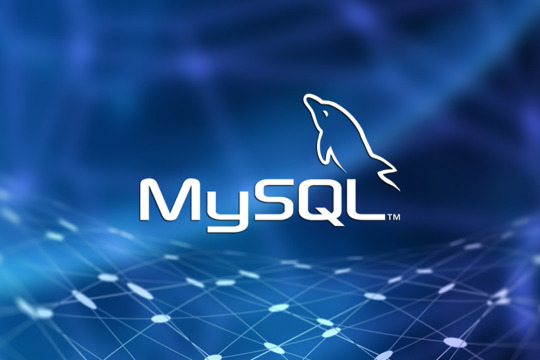
What is MySQL?
MySQL is a freely available open source Relational Database Management System (RDBMS) that uses Structured Query Language (SQL). SQL is the most popular language for adding, accessing and managing content in a database. It is most noted for its quick processing, proven reliability, ease and flexibility of use.
What is a naming convention?
In computer programming, a naming convention is a set of rules for choosing the character sequence to be used for identifiers that denote variables, types, functions, and other entities in source code and documentation.
General rules — Naming conventions
Using lowercase will help speed typing, avoid mistakes as MYSQL is case sensitive.
Space replaced with Underscore — Using space between words is not advised.
Numbers are not for names — While naming, it is essential that it contains only Alpha English alphabets.
Valid Names — Names should be descriptive of the elements. i.e. — Self-explanatory and not more than 64 characters.
No prefixes allowed.
Database name convention
Name can be singular or plural but as the database represents a single database it should be singular.
Avoid prefix if possible.
MySQL table name
Lowercase table name
MySQL is usually hosted in a Linux server which is case-sensitive hence to stay on the safe side use lowercase. Many PHP or similar programming frameworks, auto-detect or auto-generate class-based table names and most of them expect lowercase names.
Table name in singular
The table is made up of fields and rows filled with various forms of data, similarly the table name could be plural but the table itself is a single entity hence it is odd and confusing. Hence use names like User, Comment.
Prefixed table name
The table usually has the database or project name. sometimes some tables may exist under the same name in the database to avoid replacing this, you can use prefixes. Essentially, names should be meaningful and self-explanatory. If you can’t avoid prefix you can fix it using php class.
Field names
Use all above cases which include lowercase, no space, no numbers, and avoid prefix.
Choose short names no-longer than two words.
Field names should be easy and understandable
Primary key can be id or table name_id or it can be a self-explanatory name.
Avoid using reserve words as field name. i.e. — Pre-defined words or Keywords. You can add prefix to these names to make it understandable like user_name, signup_date.
Avoid using column with same name as table name. This can cause confusion while writing query.
Avoid abbreviated, concatenated, or acronym-based names.
Do define a foreign key on database schema.
Foreign key column must have a table name with their primary key.
e.g. blog_id represents foreign key id from table blog.
Avoid semantically — meaningful primary key names. A classic design mistake is creating a table with primary key that has actual meaning like ‘name’ as primary key. In this case if someone changes their name then the relationship with the other tables will be affected and the name can be repetitive losing its uniqueness.
Conclusion
Make your table and database names simple yet understandable by both database designers and programmers. It should things that might cause confusion, issues with linking tables to one another. And finally, it should be readable for programming language or the framework that is implemented.
#MySQL#DatabaseManagement#SQL#NamingConventions#RelationalDatabase#DatabaseDesign#CodingStandards#TableNaming#FieldNaming#DatabaseSchema#ProgrammingTips#DataManagement#CaseSensitivity#PrimaryKey#ForeignKey#DatabaseBestPractices#OpenSource#DatabaseOptimization#MySQLTips#DataStructure
0 notes
Text
Analysing large data sets using AWS Athena
Handling large datasets can feel overwhelming, especially when you're faced with endless rows of data and complex information. At our company, we faced these challenges head-on until we discovered AWS Athena. Athena transformed the way we handle massive datasets by simplifying the querying process without the hassle of managing servers or dealing with complex infrastructure. In this article, I’ll Walk you through how AWS Athena has revolutionized our approach to data analysis. We’ll explore how it leverages SQL to make working with big data straightforward and efficient. If you’ve ever struggled with managing large datasets and are looking for a practical solution, you’re in the right place.
Efficient Data Storage and Querying
Through our experiences, we found that two key strategies significantly enhanced our performance with Athena: partitioning data and using columnar storage formats like Parquet. These methods have dramatically reduced our query times and improved our data analysis efficiency. Here’s a closer look at how we’ve implemented these strategies:
Data Organization for Partitioning and Parquet
Organize your data in S3 for efficient querying:
s3://your-bucket/your-data/
├── year=2023/
│ ├── month=01/
│ │ ├── day=01/
│ │ │ └── data-file
│ │ └── day=02/
│ └── month=02/
└── year=2024/
└── month=01/
└── day=01/
Preprocessing Data for Optimal Performance
Before importing datasets into AWS Glue and Athena, preprocessing is essential to ensure consistency and efficiency. This involves handling mixed data types, adding date columns for partitioning, and converting files to a format suitable for Athena.
Note: The following steps are optional based on the data and requirements. Use them according to your requirements.
1. Handling Mixed Data Types
To address columns with mixed data types, standardize them to the most common type using the following code snippet:def determine_majority_type(series): # get the types of all non-null values types = series.dropna().apply(type) # count the occurrences of each type type_counts = types.value_counts()
preprocess.py
2. Adding Date Columns for Partitioning
To facilitate partitioning, add additional columns for year, month, and day:def add_date_columns_to_csv(file_path): try: # read the CSV file df = pd.read_csv(file_path)
partitioning.py
3. Converting CSV to Parquet Format
For optimized storage and querying, convert CSV files to Parquet format:def detect_and_convert_mixed_types(df): for col in df.columns: # detect mixed types in the column if df[col].apply(type).nunique() > 1:
paraquet.py
4. Concatenating Multiple CSV Files
To consolidate multiple CSV files into one for Parquet conversion:def read_and_concatenate_csv_files(directory): all_dfs = [] # recursively search for CSV files in the directory
concatenate.py
Step-by-Step Guide to Managing Datasets with AWS Glue and Athena
1. Place Your Source Dataset in S3
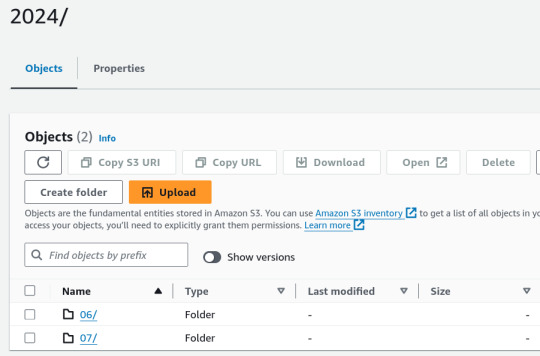
2. Create a Crawler in AWS Glue
In the AWS Glue console, create a new crawler to catalog your data and make it queryable with Athena.
Specify Your S3 Bucket: Set the S3 bucket path as the data source in the crawler configuration.
IAM Role: Assign an IAM role with the necessary permissions to access your S3 bucket and Glue Data Catalog.
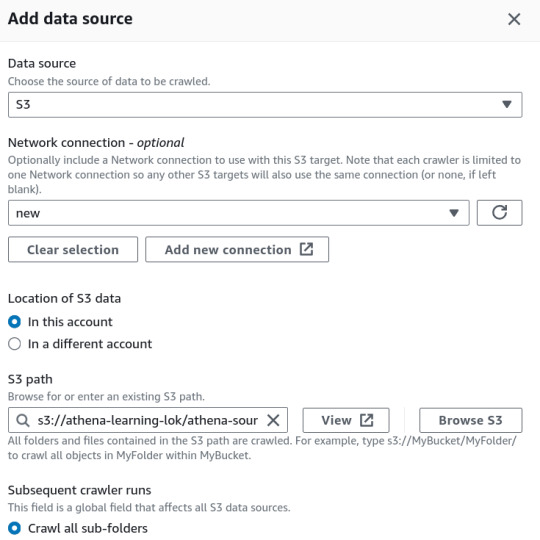
3. Set Up the Glue Database
Create a new database in the AWS Glue Data Catalog where your CSV data will be stored. This database acts as a container for your tables.
Database Creation: Go to the AWS Glue Data Catalog section and create a new database.
Crawler Output Configuration: Specify this database for storing the table metadata and optionally provide a prefix for your table names.
4. Configure Crawler Schedule
Set the crawler schedule to keep your data catalog up to date:
Hourly
Daily
Weekly
Monthly
On-Demand
Scheduling the crawler ensures data will be updated to our table, if any updates to existing data or adding of new files etc.
5. Run the Crawler
Initiate the crawler by clicking the "Run Crawler" button in the Glue console. The crawler will analyze your data, determine optimal data types for each column, and create a table in the Glue Data Catalog.
6. Review and Edit the Table Schema
Post-crawler, review and modify the table schema:
Change Data Types: Adjust data types for any column as needed.
Create Partitions: Set up partitions to improve query performance and data organization.

7. Query Your Data with AWS Athena
In the Athena console:
Connect to Glue Database: Use the database created by the Glue Crawler.
Write SQL Queries: Leverage SQL for querying your data directly in Athena.
8. Performance Comparison
After the performance optimizations, we got the following results:
To illustrate it, I ran following queries on 1.6 GB data:
For Parquet data format without partitioning
SELECT * FROM "athena-learn"."parquet" WHERE transdate='2024-07-05';
For Partitioning with CSV

Query Runtime for Parquet Files: 8.748 seconds. Parquet’s columnar storage format and compression contribute to this efficiency.
Query Runtime for Partitioned CSV Files: 2.901 seconds. Partitioning helps reduce the data scanned, improving query speed.
Data Scanned for Paraquet Files: 60.44MB
Data Scanned for Partitioned CSV Files: 40.04MB
Key Insight: Partitioning CSV files improves query performance, but using Parquet files offers superior results due to their optimized storage and compression features.
9. AWS Athena Pricing and Optimization
AWS Athena pricing is straightforward: you pay $5.00 per terabyte (TB) of data scanned by your SQL queries. However, you can significantly reduce costs and enhance query performance by implementing several optimization strategies.
Conclusion
AWS Athena offers a powerful, serverless SQL interface for querying large datasets. By adopting best practices in data preprocessing, organization, and Athena usage, you can manage and analyze your data efficiently without the overhead of complex infrastructure.
0 notes
Link
SQL Server: How to Use the ADD Keyword for Schema Changes
When working with SQL Server, managing and modifying database schemas is a fundamental task. One of the key operations you might frequently perform is adding new columns, constraints, or indexes to your existing tables. This is where the ADD keyword becomes incredibly useful. This blog post will delve into how to effectively use the ADD keyword in SQL Server to perform schema changes, complete with code examples to illustrate each scenario...
Learn more here:
https://www.nilebits.com/blog/2024/07/sql-server-add-keyword-for-schema-changes/
0 notes
Text
SQL and NoSQL: Differences, Use cases and Databases
SQL and NoSQL are counter technologies meant to accomplish the same business goals. The difference mainly exists in the autonomy to ‘explore data deeply’ and ‘ease of scalability’
SQL has existed as a widely accepted industry standard for so long now. Its counterpart; NoSQL, emerged almost 12 years ago when the world needed a disparate system that could process unstructured data as well as comply with increasing storage and power requirements.
The rise of NoSQL almost diminished the decade old SQL paradigm of relational database management system (RDBMS) giving rise to non relational database systems.
Now as we see, SQL didn’t go away, instead its potential to manipulate data in databases is increasingly realized.
In this article, we explore sql and nosql difference, sql vs. nosql use cases, and comparison of databases.
SQL and NoSQL Difference
The differences in SQL and NoSQL exist among four key parameters: Language, Scalability, Structure, and Transaction Processing.
Language
SQL is used to query structured data only. Structured data exists in the form of rows and columns (2D tables) and therefore exert the constraint for a carefully built schema before querying data.
That’s because for data whose structure could not be defined; data from mobile applications, and SAP systems with a lot of varying fields where new fields occur every now and then, SQL fails given its syntax and control flow that works only for table based data.
Apart from the structure constraint on data, SQL has been well nurtured in the past 40 years to offer wide functionality for complex queries, and is secure in usage.
The learning curve of SQL is also short compared to other programming languages (including NoSQL). Moreover, all the variants of SQL including for example SQL server, and MySQL have a great amount of similarity in usage and therefore are easily learnt across the globe.
NoSQL has its own advantages over SQL. It offers the flexibility to query unstructured data (with a dynamic schema not limited to representing data in rows and columns). This means now each type of data could have alternate structure all stored beside each other in a single database.
NoSQL was introduced some 12 years ago with the aim of utilization of unstructured or loosely structured data in database applications.
There’s freedom from rigorous data engineering before the storage to use the data for BI and ML applications. NoSQL offers greater exploration of data in that the raw data is directly fed to the system for storage and after that the BI and ML engineers could build schemas as they like.
The spotlight on NoSQL waned when its users realized it lacked standardization and wide documentation leading to difficulty in carrying out complex queries.
Moreover, NoSQL language varies across databases where each database (MongoDB, Cassandra, etc) have their completely varying versions of noSQL.CategorySQLNoSQLLanguageStructured data onlyStructured and unstructuredScalabilityVerticalHorizontalStructureTable format4 Types incl. columnar formatTransactionsACID complianceCAP theoremSQL vs. NoSQL Difference
Scalability
Scalability is one of the most distinctive features of SQL and NoSQL databases. For the scope of this article, we define scalability as the capacity of a system to process a number of concurrent queries.
The ease of adding and removing processing resources for the purpose of supporting concurrent users determines the effectiveness of scalability.
SQL supports vertical scalability that means new processing resources could be added within the same server. It’s based on the actor model that uses multiple CPU cores. All the processor cores participate in processing over the same data.
NoSQL adopts the horizontal scalability that instead of adding cores to CPU adds new servers in parallel to old ones. It uses a master/slave architecture where a master processor divides data among slave processors.
In essence, horizontal scaling is more desirable due to its ability to divide data across parallel machines. This way it enables faster processing from utilization of all resources in less time. Whereas vertical scaling, although much easier to implement, lacks the kind of linear scalability as in horizontal scaling.
Learn more about differences in horizontal scalability and vertical scalability here.
Structure
SQL databases store data in rows and columns where a column represents a specific data type only. While making these tables some rules are defined to maintain the integrity of data as well as making it efficient for the querying process.
NoSQL databases don’t conform to this tabular structure, and don’t require data engineering such as above. Instead they use other formats that are more flexible to add any kind of data desired. These formats are:
Column-oriented structure: Data resides in columns however these columns support any kind of data type. It results in high dimensional data.
Key-Value structure: Data objects are defined and a unique key is assigned to each object.
Document stores: specifically holds semi-structured data where some of the data is structured, while it may contain other data that has no defined column category.
Graph databases: It uses nodes and relationships to structure data instead of a table or a document. Nodes present data elements while relationships present how they are related to each other.
Learn more about Graph databases in this comprehensive article.
Transaction Processing
As you may be well aware that SQL databases process transactions in such a way as to minimize the erroneous events that might affect the data. For this, it uses the ACID rules. These are the:
Atomicity of a transaction prevents it from getting saved when it’s incomplete. A transaction is either saved when it’s completed only or failed otherwise.
Consistency prevents data from being corrupted by following rules at each step of transactional processing.
Isolation keeps away multiple users to change the same data at same time.
Durability records a transaction once it is made. No roll back can be done after a transaction is saved.
In distributed systems as a copy of data is stored on all distributed nodes through replication the transactional processing is a little different. NoSQL uses the CAP theorem that is specifically designed for successful transaction processing on distributed systems.
Consistency ensures the delivery of latest results where sometimes in case of a node separated from the system due to a network failure might not receive the updated information. An error message must be sent to the user instead of an unlatest value fetched from a node.
Availability, unlike a consistent system, ensures that a transaction is always successful (returning a non-error result) even when there’s network failure.
Partition Tolerance is a phenomenon for uninterruptible system performance in case of a network failure between parallel systems. More than one link is created among nodes such that if a link fails, there are other links that duplicate data to other nodes.
In NoSQL databases, only two properties are fulfilled at a time, that is, either CA, CP, or AP.
Learn more about the CAP theorem with example cases in this insightful article.
SQL vs NoSQL Use Cases
SQL databases are preferred when scalability requirements are not very large. This simply means it won’t support concurrent requests from a large number of users such as those in big data applications.
Big data applications demand storage of huge sized and highly varied data that arrives very frequently on databases. These applications require processing of both structured and unstructured data as well as require high scalability needs.
For big data applications, NoSQL databases have immense use cases and are preferred over SQL based solutions.
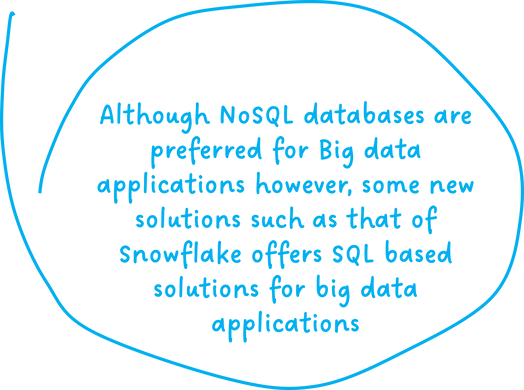
Quite surprisingly, today we see some unique database solutions that leverage the SQL language to query ‘big data’ stored across the distributed systems in the cloud. Examples include Snowflake’s relational database that is scalable as well as capable of storing semi-structured data.
Learn more about Snowflake’s unique approach in this comprehensive article.
Databases
Today the old SQL based databases have started to invent NoSQL like features to compete against the rising technology.
We call it ‘Combined Strength’ that uses the good points of both technologies to enable rich and more flexible database experience.
Today MySQL of Oracle has evolved to support semi-structured data such as JSON and document based files along with support for horizontal scaling
Meanwhile, on the non-relational end, NoSQL databases such as MongoDB also offer relational features such as indexing, aggregation queries, and ACID compliance in its document based data format.
Moreover, the noSQL databases have increasingly adopted a SQL-based syntax for attracting data analysts and data scientists who have extensive SQL experience and limited programing knowhow.
Adding to that, Cassandra has CQL, Spark developed SparkQL, and JIRA developed JQL.
Although the NoSQL databases have a lot to offer through its support for programming languages, building a SQL-like support can empower those with SQL know-how to use the best of their knowledge.
Conclusion
The SQL vs. NoSQL debate has evolved from a clear-cut dichotomy to a more nuanced understanding of their strengths and weaknesses. Modern databases often blend elements of both approaches, offering flexibility and scalability.
Dicecamp's Data Engineering Course Using SQL Server Tools could be a valuable resource for individuals looking to master SQL and its applications in the modern data landscape. By focusing on SQL Server tools, the course likely equips students with practical skills to work with relational databases and potentially explore their integration with NoSQL technologies.
Would you like to learn more about specific SQL Server tools or how they can be used in conjunction with NoSQL databases.
0 notes
Text
Creating an Effective Power BI Dashboard: A Comprehensive Guide

Introduction to Power BI Power BI is a suite of business analytics tools that allows you to connect to multiple data sources, transform data into actionable insights, and share those insights across your organization. With Power BI, you can create interactive dashboards and reports that provide a 360-degree view of your business.
Step-by-Step Guide to Creating a Power BI Dashboard
1. Data Import and Transformation The first step in creating a Power BI dashboard is importing your data. Power BI supports various data sources, including Excel, SQL Server, Azure, and more.
Steps to Import Data:
Open Power BI Desktop.
Click on Get Data in the Home ribbon.
Select your data source (e.g., Excel, SQL Server, etc.).
Load the data into Power BI.
Once the data is loaded, you may need to transform it to suit your reporting needs. Power BI provides Power Query Editor for data transformation.
Data Transformation:
Open Power Query Editor.
Apply necessary transformations such as filtering rows, adding columns, merging tables, etc.
Close and apply the changes.
2. Designing the Dashboard After preparing your data, the next step is to design your dashboard. Start by adding a new report and selecting the type of visualization you want to use.
Types of Visualizations:
Charts: Bar, Line, Pie, Area, etc.
Tables and Matrices: For detailed data representation.
Maps: Geographic data visualization.
Cards and Gauges: For key metrics and KPIs.
Slicers: For interactive data filtering.
Adding Visualizations:
Drag and drop fields from the Fields pane to the canvas.
Choose the appropriate visualization type from the Visualizations pane.
Customize the visual by adjusting properties such as colors, labels, and titles.
3. Enhancing the Dashboard with Interactivity Interactivity is one of the key features of Power BI dashboards. You can add slicers, drill-throughs, and bookmarks to make your dashboard more interactive and user-friendly.
Using Slicers:
Add a slicer visual to the canvas.
Drag a field to the slicer to allow users to filter data dynamically.
Drill-throughs:
Enable drill-through on visuals to allow users to navigate to detailed reports.
Set up drill-through pages by defining the fields that will trigger the drill-through.
Bookmarks:
Create bookmarks to capture the state of a report page.
Use bookmarks to toggle between different views of the data.
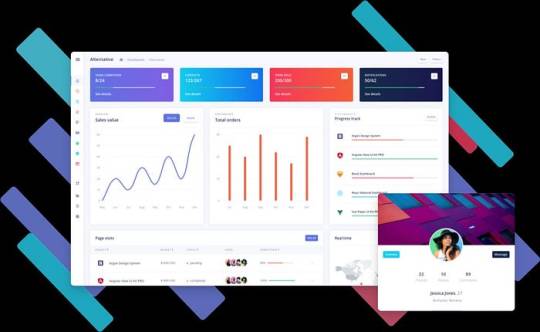
Different Styles of Power BI Dashboards Power BI dashboards can be styled to meet various business needs. Here are a few examples:
1. Executive Dashboard An executive dashboard provides a high-level overview of key business metrics. It typically includes:
KPI visuals for critical metrics.
Line charts for trend analysis.
Bar charts for categorical comparison.
Maps for geographic insights.
Example:
KPI cards for revenue, profit margin, and customer satisfaction.
A line chart showing monthly sales trends.
A bar chart comparing sales by region.
A map highlighting sales distribution across different states.
2. Sales Performance Dashboard A sales performance dashboard focuses on sales data, providing insights into sales trends, product performance, and sales team effectiveness.
Example:
A funnel chart showing the sales pipeline stages.
A bar chart displaying sales by product category.
A scatter plot highlighting the performance of sales representatives.
A table showing detailed sales transactions.
3. Financial Dashboard A financial dashboard offers a comprehensive view of the financial health of an organization. It includes:
Financial KPIs such as revenue, expenses, and profit.
Financial statements like income statement and balance sheet.
Trend charts for revenue and expenses.
Pie charts for expense distribution.
Example:
KPI cards for net income, operating expenses, and gross margin.
A line chart showing monthly revenue and expense trends.
A pie chart illustrating the breakdown of expenses.
A matrix displaying the income statement.
Best Practices for Designing Power BI Dashboards To ensure your Power BI dashboard is effective and user-friendly, follow these best practices:
Keep it Simple:
Avoid cluttering the dashboard with too many visuals.
Focus on the most important metrics and insights.
2. Use Consistent Design:
Maintain a consistent color scheme and font style.
Align visuals properly for a clean layout.
3. Ensure Data Accuracy:
Validate your data to ensure accuracy.
Regularly update the data to reflect the latest information.
4. Enhance Interactivity:
Use slicers and drill-throughs to provide a dynamic user experience.
Add tooltips to provide additional context.
5. Optimize Performance:
Use aggregations and data reduction techniques to improve performance.
Avoid using too many complex calculations.
Conclusion Creating a Power BI dashboard involves importing and transforming data, designing interactive visuals, and applying best practices to ensure clarity and effectiveness. By following the steps outlined in this guide, you can build dashboards that provide valuable insights and support data-driven decision-making in your organization. Power BI’s flexibility and range of visualizations make it an essential tool for any business looking to leverage its data effectively.
#Dynamic Data Visualization#Business Analytics#Interactive Dashboards#Data Insights#Data Transformation#KPI Metrics#Real-time Reporting#Data Connectivity#Trend Analysis#Visual Analytics#Performance Metrics#Data Modeling#Executive Dashboards#Sales Performance#Financial Reporting#Data Interactivity#Data-driven Decisions#Power Query#Custom Visuals#Data Integration
0 notes
Text
Setting References, Adding constraints
We need to set up some items so that eventually this project will actually run. First off, we need to set up a reference to an existing server where the project will be exported when we're finished.
Under the Solution's name, there is a entry for References. Right-click on that, then select Database References. Change the database reference type to System Database, and select the master database.
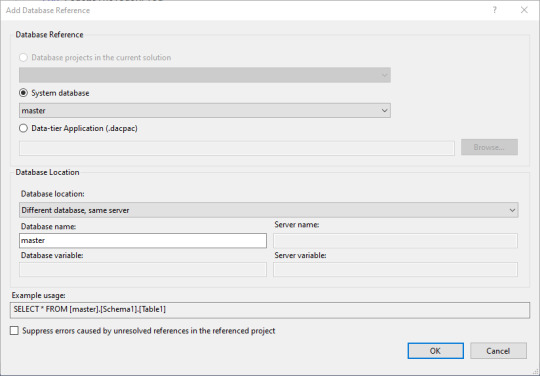
Just to be fair, I had trouble with adding the default as below. I kept getting an error SLQ17501, meaning the editor was unable to find the referred to item.
There is an equivalent of SSMS' Crtl+Shift+R, which in the Project menu then Reanalyze Project. And that didn't work. It's supposed to take a little bit like the refresh of the table data into IntelliSense does in SSMS, so I waited. Hours.
Then I deleted the offending item and tried to add it again. Still there.
Then deleted the entire project and started over. At that point, in the error listing, I noticed the project was set for "Build + Intellisense". Clicking the other options confirmed that the problem was in IntelliSense, not the Build.
Next day, I started off with a new and smaller build and planned on using VS to report the issue to Microsoft. And it never came back. Anywhere. Computer Science is in the next classroom, this is working with software, which is a whole different beast. End interruption.
The source table has the one constraint already, which is the clustered primary key. "Clustered" means that the data will be put in the specified order onto the drive. Primary keys have to be non-null and unique, and are often what is used as a foreign key in another table.
This is a table of dates, and there's already date functions and tools built in to SQL. Why add more? Mostly so that we have a simple table to join on for long calculations. You can figure out if a given day is a weekend by looking at the DatePart() function with the first parameter set to DW. But is it a holiday? That is a bit harder to work out. This table does the calculations so they don't have to be repeated endlessly.
First off, let's set the FederalHolidayFlag to default to the character 'N'. We do the right-click on the solution's name, then Add, then New Item. Under Tables and Views we can select a Default Constraint. And it wants a name again.
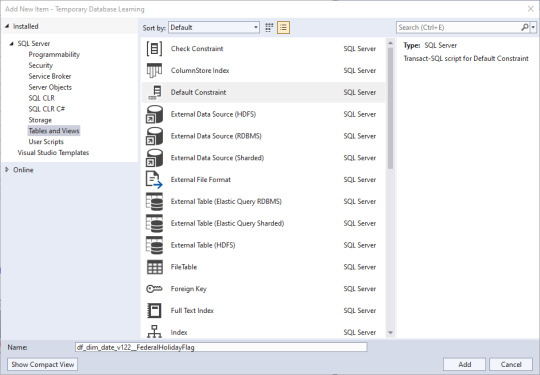
And VS is helping where it can.


There's a related Check Constraint. Everybody is going to have opinions about where each of the files should be one single step, or if all the related steps should stay together. Make a choice that appeals to you, and realize unless you're the project manager it doesn't matter. I want the practice using the different templates.

The blue squiggle is error SQL70588 - since there's already a data enforcement check on that column, the WITH CHECK part of the statement will be ignored. I'm making a note that the Test Suite needs to look at that.
Document it. Always. Or you will forget.
Why use 'Y' and 'N'? One byte is the smallest column size. The boolean columns do only take up one bit in some byte, but unless you have a lot of booleans (8 or more), it's not much of a savings in space and a tad more work in CPU - probably breaks even in the long run. We could have used 0 and 1 in a tinyint column. It was an aesthetic choice on the part of the Data Architect team.
There are a bunch more constraints we could put in. Which ones matter to you?
0 notes